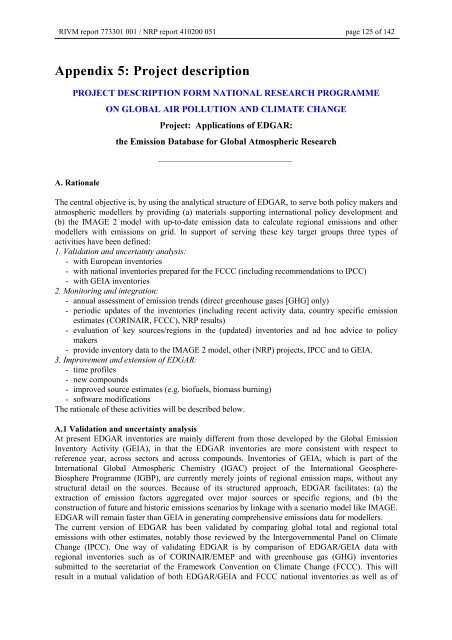RIVM report xxxxxx xxx
RIVM report xxxxxx xxx
RIVM report xxxxxx xxx
You also want an ePaper? Increase the reach of your titles
YUMPU automatically turns print PDFs into web optimized ePapers that Google loves.
<strong>RIVM</strong> <strong>report</strong> 773301 001 / NRP <strong>report</strong> 410200 051 page 125 of 142<br />
$SSHQGL[3URMHFWGHVFULSWLRQ<br />
352-(&7'(6&5,37,21)2501$7,21$/5(6($5&+352*5$00(<br />
21 */2%$/$,532//87,21$1'&/,0$7(&+$1*(<br />
3URMHFW $SSOLFDWLRQVRI('*$5<br />
WKH(PLVVLRQ'DWDEDVHIRU*OREDO$WPRVSKHULF5HVHDUFK<br />
$5DWLRQDOH<br />
The central objective is, by using the analytical structure of EDGAR, to serve both policy makers and<br />
atmospheric modellers by providing (a) materials supporting international policy development and<br />
(b) the IMAGE 2 model with up-to-date emission data to calculate regional emissions and other<br />
modellers with emissions on grid. In support of serving these key target groups three types of<br />
activities have been defined:<br />
9DOLGDWLRQDQGXQFHUWDLQW\DQDO\VLV<br />
- with European inventories<br />
- with national inventories prepared for the FCCC (including recommendations to IPCC)<br />
- with GEIA inventories<br />
0RQLWRULQJDQGLQWHJUDWLRQ<br />
- annual assessment of emission trends (direct greenhouse gases [GHG] only)<br />
- periodic updates of the inventories (including recent activity data, country specific emission<br />
estimates (CORINAIR, FCCC), NRP results)<br />
- evaluation of key sources/regions in the (updated) inventories and ad hoc advice to policy<br />
makers<br />
- provide inventory data to the IMAGE 2 model, other (NRP) projects, IPCC and to GEIA.<br />
,PSURYHPHQWDQGH[WHQVLRQRI('*$5<br />
- time profiles<br />
- new compounds<br />
- improved source estimates (e.g. biofuels, biomass burning)<br />
- software modifications<br />
The rationale of these activities will be described below.<br />
$9DOLGDWLRQDQGXQFHUWDLQW\DQDO\VLV<br />
At present EDGAR inventories are mainly different from those developed by the Global Emission<br />
Inventory Activity (GEIA), in that the EDGAR inventories are more consistent with respect to<br />
reference year, across sectors and across compounds. Inventories of GEIA, which is part of the<br />
International Global Atmospheric Chemistry (IGAC) project of the International Geosphere-<br />
Biosphere Programme (IGBP), are currently merely joints of regional emission maps, without any<br />
structural detail on the sources. Because of its structured approach, EDGAR facilitates: (a) the<br />
extraction of emission factors aggregated over major sources or specific regions, and (b) the<br />
construction of future and historic emissions scenarios by linkage with a scenario model like IMAGE.<br />
EDGAR will remain faster than GEIA in generating comprehensive emissions data for modellers.<br />
The current version of EDGAR has been validated by comparing global total and regional total<br />
emissions with other estimates, notably those reviewed by the Intergovernmental Panel on Climate<br />
Change (IPCC). One way of validating EDGAR is by comparison of EDGAR/GEIA data with<br />
regional inventories such as of CORINAIR/EMEP and with greenhouse gas (GHG) inventories<br />
submitted to the secretariat of the Framework Convention on Climate Change (FCCC). This will<br />
result in a mutual validation of both EDGAR/GEIA and FCCC national inventories as well as of
















